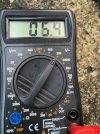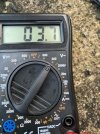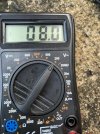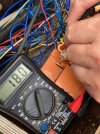I've frequently confessed my illiteracy on the electronics side of our hobby, and that my brother-in-law fortunately is an electrician and happy to help keep things ticking over. He bought me a voltmeter for Christmas, bless him, but the results have been puzzling me since I got it. He was here yesterday and is equally puzzled (but freely admits it might be a 'digital; thing, which he understands less well.)
Basically when testing the track for power the meter readings just jump around and certainly hardly ever reach 18v. See the first 4 photos, which is from the same test. He's sure the meter is OK, he tested it on a battery, and then as the fifth photo shows tested it on the switch box which is powered from the LGB transformer and not the Massoth central station. Solid 18v every time.
So what's going on here on the track? The actual performance on the tracks is generally fine, we fixed a little niggle with one point yesterday but otherwise every loco is happy - but you wouldn't expect it from those meter readings...
Basically when testing the track for power the meter readings just jump around and certainly hardly ever reach 18v. See the first 4 photos, which is from the same test. He's sure the meter is OK, he tested it on a battery, and then as the fifth photo shows tested it on the switch box which is powered from the LGB transformer and not the Massoth central station. Solid 18v every time.
So what's going on here on the track? The actual performance on the tracks is generally fine, we fixed a little niggle with one point yesterday but otherwise every loco is happy - but you wouldn't expect it from those meter readings...





